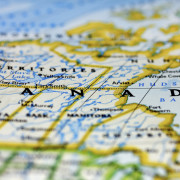“The overall mission and goals of the company have remained virtually unchanged throughout our history.” – John Fisher, Founder – DMTI Spatial
In 1994, DMTI Spatial was born with the purpose of helping our customers improve the way they did business by leveraging the power of location. We knew that location was special, and had enormous potential to improve decision making and operations, and we had a unique ability to harness it.
We set out to be a software company, but we found that the software was useless without good foundation mapping to support it. So first we built the maps. We could have done what others were doing – driving the roads to build the maps. But we wanted to create foundation data for many purposes, not just navigation – so we needed a better way.
Canada – the birthplace for GIS
Being based in Canada, we were fortunate. A country as large as Canada with a relatively small population needs a way to administer the huge tracts of land very efficiently. Because of this there was a huge legacy of digital map data available. The only problem: it was a patchwork of uncoordinated bits. It needed to be seamed together from a variety of sources.
We figured the only way to accomplish this massive undertaking was to automate as much as possible. So we did. We created software to do most of the work, and supplemented with skilled labour (GIS technicians) to handle what the automation couldn’t.
Canada’s first digital street map
DMTI Spatial created the first coast-to-coast digital street map for Canada, using the National Topographic Database from Natural Resources Canada as the primary base, supplemented by many other federal, provincial and municipal datasets. We called it CanMap®, and it was the definitive Canadian base map for digital applications.
As our customers became more sophisticated in their use of the technology, there was a need to add more depth and precision to our maps. We added hundreds of layers of data to the street map fabric, including postal geography, electoral geography, 3 dimensional Digital Elevation Model (DEM) data and many others. We built a complete, seamless water layer for Canada, connecting all of the streams, lakes and rivers. For inter-modal transportation, we created a national rail network. For the mobile phone industry we created coast-to-coast clutter mapping for radio propagation analysis – which was used by telecommunications companies to deploy national cellular coverage. We built land use models, assembled demographics and built point of interest data.
And we called it CanMap 2.0
CanMap 2.0 set a new bar for location data excellence in the marketplace.
Others sought us out to build data for them and we built out over 10 million parcel boundaries for the U.S. for First American®.
A history of firsts
A fundamental tool for using location data efficiently is the geocoder. We were not happy with the quality of the available geocoders, so we set out to build our own. Based on our superior knowledge of Canadian geography and Canadian addresses we designed a solution that would make use of the high precision and extensive attribution of the CanMap base. Since Canada is bilingual we created a French-English geocoder, the first in the world.
To add greater precision we developed point level addresses – another first – and incorporated this data into the first point address geocoder.
By the time DMTI Spatial was 10 years old we had a huge catalogue of data products with thousands of variations. We began to combine our technology and data with others in new and different ways to create new hybrid products.
Thinking outside the box
Around this time we came up with a revolutionary new idea – why not combine the digital vector data such as our CanMap street maps with raster imagery – satellite and airborne – to create a new hybrid map/image? We approached Digital Globe and proposed a partnership – a co-branded product we called Satellite Streetview. Digital Globe was so impressed with this product that they started showing it around, and caught the attention of an internet search company. That company was Google™.
Our customers began to ask how were able to combine such large volumes of disparate data into one seamless database. They said that they had similar issues with their own data and wondered if we could help. To solve this problem we repurposed our internal data consolidation software and geocoding software, and Location Hub® was born.
A key innovation was the development and use of a persistent location ID – the Unique Address Identifier (UAID®), as a simple, elegant way to tie all data associated with a particular location to one unambiguous index key.
Based on the success of Location Hub and the UAID we then expanded this capability to embrace the wide world of 3rd party data. If we were able to stamp all incoming data records with a UAID, then any database processed through Location Hub would be instantly integrated with all other datasets processed through the Hub. And so the Location Economics Ecosystem was born.
What’s in store for 2015?
With all this data and processing power available in one software platform, the next logical step was to add analytics to the mix. DMTI Spatial is getting ready to deploy a new Location-based analytics product this spring. It’s totally new to the spatial visualization field, is incredibly fast and efficient at profiling, requires very little data awareness and manipulation, and is geared to fit multiple verticals without breaking much of a sweat.
Building on our heritage of innovation and creativity, we continue will to help businesses grow through actionable insights uncovered by leveraging location to bring together and analyze a growing world of data. We will continue to make breakthrough products that change the way people use location.
~ John Fisher, Founder – DMTI Spatial
Click here to see how DMTI helps businesses throughout Canada leverage location technology.







